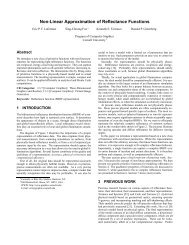pigmented colorants: dependence on media and time - Cornell ...
pigmented colorants: dependence on media and time - Cornell ...
pigmented colorants: dependence on media and time - Cornell ...
Create successful ePaper yourself
Turn your PDF publications into a flip-book with our unique Google optimized e-Paper software.
3.1.6 Overall Resp<strong>on</strong>se<br />
One can easily quantify a light source’s spectral intensity <strong>and</strong> the reflectivity of<br />
a material through careful measurements. Through experimentati<strong>on</strong>, the average<br />
human’s perceptual resp<strong>on</strong>se for each type of photoreceptor can also be determined.<br />
Together, this should determine the overall resp<strong>on</strong>se of a typical viewer for a given<br />
stimulus. However, this is not the case, as the human brain is very subjective <strong>and</strong><br />
does not evaluate a color in isolati<strong>on</strong>. The surrounding envir<strong>on</strong>ment has a great<br />
deal of influence <strong>on</strong> a color.<br />
Previously, the opp<strong>on</strong>ent nature of human visi<strong>on</strong> was discussed. The human<br />
eye detects differences between neural impulses <strong>and</strong> magnifies them. This process<br />
takes place after the photoreceptors have elicited a resp<strong>on</strong>se from the stimulus.<br />
Retinal gangli<strong>on</strong> cells collect neural impulses from photoreceptors <strong>and</strong> c<strong>on</strong>denses<br />
them by approximately 80 <strong>time</strong>s [SB02], preserving the important features of the<br />
original signals. Gangli<strong>on</strong> cells each have a receptor field <strong>on</strong> the retina, a patch<br />
within which a cell’s activity may be influenced. Light outside of this regi<strong>on</strong> has<br />
no effect <strong>on</strong> the cell. The receptor field roughly takes the shape of two c<strong>on</strong>centric<br />
circles. One regi<strong>on</strong> within the field resp<strong>on</strong>ds to an increase in light, while the<br />
other resp<strong>on</strong>ds to a decrease in light. We will refer to these regi<strong>on</strong>s as ’<strong>on</strong>’ <strong>and</strong><br />
’off’ resp<strong>on</strong>ses, respectively.<br />
Imagine the center of a receptor field has an <strong>on</strong> resp<strong>on</strong>se, while the ring is<br />
an off resp<strong>on</strong>se, as in Figure 3.28(a). If the cell undergoes uniform illuminati<strong>on</strong>,<br />
the cell <strong>on</strong>ly gives a weak resp<strong>on</strong>se. This is because such a stimulus produces<br />
opposite effects in the center <strong>and</strong> surrounding area–the center is excited, while the<br />
ring inhibits the resp<strong>on</strong>se. This interacti<strong>on</strong> is called lateral inhibiti<strong>on</strong>, which is the<br />
antag<strong>on</strong>istic neural interacti<strong>on</strong> between adjacent photoreceptors in the retina.<br />
85



